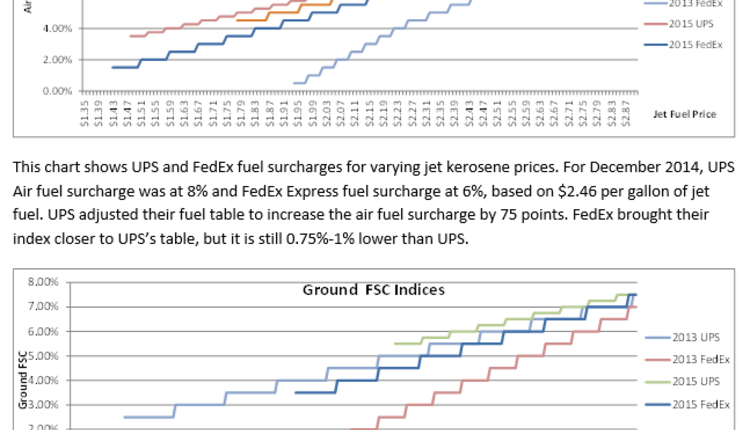Talking to your carrier more frequently can help you save money and improve operations. Most shippers talk to their carriers when there is an operational problem or when their agreements are being renewed. If the packages are being picked up daily and delivered to their destinations on time, not much dialogue goes on between the shipper and the carrier, and status-quo is maintained.
However with any vendor, a continuous dialogue will help improve your bottom line and keep you up-to-date in means of current services and technologies being offered. Here are a few examples that could help you:
New services: Every year or two the carriers introduce a new service or restructure existing services. FedEx Smartpost / UPS Basic are two examples. If there is some flexibility with time in transit, shippers can use these expedited services to take advantage of lower pricing. The service details change from time to time, such as Basic Plus vs Basic, where some of the last mile delivery could be handled by UPS instead of USPS.
On a similar note the rules of the game get modified frequently, such as the recent changes to the dimensional divisors. An open conversation with your carrier will let you know of changes like this ahead of time so that you can take measures to fix or alleviate the affects to your operations.
Packaging: Carriers can help you test your packaging to make sure that it performs well protecting the goods inside. Also the dimensions are important as they affect the total weight and applicable surcharges. Reengineering your boxes can reduce the dimensional weight, as well as avoid additional handling and large package surcharges.
A more detailed analysis on your shipping data would show any optimization opportunities where low weight packages going to the same destination could be overboxed to reduce the total number of packages, resulting in lower transportation costs.
Network: Shippers want late pickups and short transit times. This depends in part on the carriers’ network of air and ground hubs. If you are close to a hub, the carrier might offer pickups at 7PM, whereas if you are 150 miles away from the closest hub, this is probably out of reach. In a similar approach, the carrier might provide you better pricing if your warehouse location is optimal for their network. Talk to your carrier when you are planning to add or modify your network. On the other hand, you should never tie your hands and structure your network based solely on a single carrier, as you might consider switching carriers in the future.
Zone-jumps: There are times when you have heavy volumes going to high zones, but the cost of adding a new DC is not justifiable. Zone-jumps could be the answer in these cases. You can segregate your packages based on destination, load them on a truck and deliver it to a carrier hub near your final destination. This has to be coordinated with the carrier, as the labels, zones, pickup times, etc. will need to be adjusted. Zone-jumps could save you money while improving transit times depending on the volume and origin / destination.
These are only a couple of snapshots from the big picture. An experienced transportation consultant can help you identify these and other points where some improvements can help your bottom line. Also a consultant can help you initiate a dialogue with your carrier, tell you if your operations align with industry standards, compare your terms to benchmarks, keep you up-to-date with new services being offered or service changes that could affect your cost and operations. In a way, the consultant can act like a relationship counselor, so that you and the carrier can get the most out of your relationship.
Baris Tasdelen is a Senior Transportation Analyst at enVista. He helps build and run data models to help identify cost and operational improvements for parcel and LTL shippers. He can be reached at btasdelen@envistacorp.com.
However with any vendor, a continuous dialogue will help improve your bottom line and keep you up-to-date in means of current services and technologies being offered. Here are a few examples that could help you:
New services: Every year or two the carriers introduce a new service or restructure existing services. FedEx Smartpost / UPS Basic are two examples. If there is some flexibility with time in transit, shippers can use these expedited services to take advantage of lower pricing. The service details change from time to time, such as Basic Plus vs Basic, where some of the last mile delivery could be handled by UPS instead of USPS.
On a similar note the rules of the game get modified frequently, such as the recent changes to the dimensional divisors. An open conversation with your carrier will let you know of changes like this ahead of time so that you can take measures to fix or alleviate the affects to your operations.
Packaging: Carriers can help you test your packaging to make sure that it performs well protecting the goods inside. Also the dimensions are important as they affect the total weight and applicable surcharges. Reengineering your boxes can reduce the dimensional weight, as well as avoid additional handling and large package surcharges.
A more detailed analysis on your shipping data would show any optimization opportunities where low weight packages going to the same destination could be overboxed to reduce the total number of packages, resulting in lower transportation costs.
Network: Shippers want late pickups and short transit times. This depends in part on the carriers’ network of air and ground hubs. If you are close to a hub, the carrier might offer pickups at 7PM, whereas if you are 150 miles away from the closest hub, this is probably out of reach. In a similar approach, the carrier might provide you better pricing if your warehouse location is optimal for their network. Talk to your carrier when you are planning to add or modify your network. On the other hand, you should never tie your hands and structure your network based solely on a single carrier, as you might consider switching carriers in the future.
Zone-jumps: There are times when you have heavy volumes going to high zones, but the cost of adding a new DC is not justifiable. Zone-jumps could be the answer in these cases. You can segregate your packages based on destination, load them on a truck and deliver it to a carrier hub near your final destination. This has to be coordinated with the carrier, as the labels, zones, pickup times, etc. will need to be adjusted. Zone-jumps could save you money while improving transit times depending on the volume and origin / destination.
These are only a couple of snapshots from the big picture. An experienced transportation consultant can help you identify these and other points where some improvements can help your bottom line. Also a consultant can help you initiate a dialogue with your carrier, tell you if your operations align with industry standards, compare your terms to benchmarks, keep you up-to-date with new services being offered or service changes that could affect your cost and operations. In a way, the consultant can act like a relationship counselor, so that you and the carrier can get the most out of your relationship.
Baris Tasdelen is a Senior Transportation Analyst at enVista. He helps build and run data models to help identify cost and operational improvements for parcel and LTL shippers. He can be reached at btasdelen@envistacorp.com.









